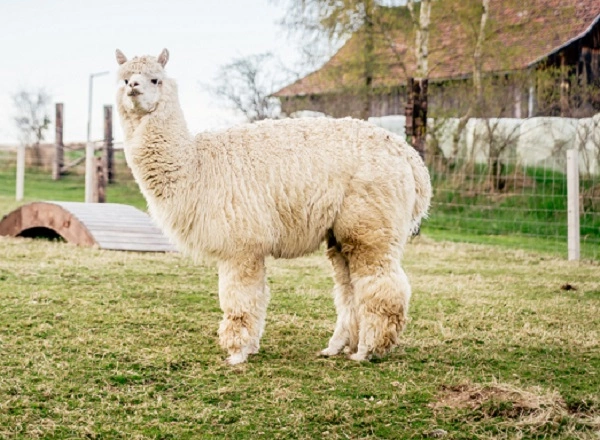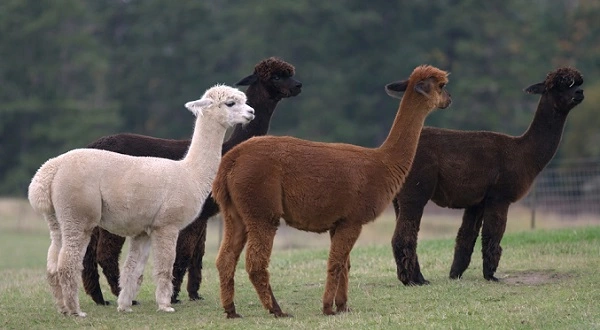Alpacas are one of the many types of animals that can be found at an alpaca farm. They are gentle creatures that are known for their soft wool. Alpacas have been around for centuries and continue to be a popular choice for those looking for a unique pet. If you’re interested in learning more about these animals, keep reading. You’ll learn everything you need to know, from what they eat to how they interact with humans. Alpacas make great pets and provide hours of enjoyment for anyone who loves spending time with animals.

Alpaca Description
Alpacas are a domesticated species of South American camelid, particularly related to the llama. They were bred specifically for their fiber, which is soft, durable, and hypoallergenic. Alpacas are kept in herds that graze on the level heights of the Andes of southern Peru, northern Bolivia, Ecuador, and northern Chile at an altitude of 3,500 m (11,500 ft) to 5,000 m (16,000 ft). Alpacas have been imported to other countries such as Australia and the United States. An alpaca’s coat is composed of specialized hair follicles that produce acclimated fleece prized for softness and lack of lanolin. Like all camelids, alpacas are ruminants that build up their four-chambered stomachs over time to digest their food properly.
Alpaca Habitat
Alpacas are native to the South American countries of Peru, Bolivia, Chile, and Argentina. They inhabit a wide range of habitats, from the barren plains of the Altiplano to the humid rainforests of the Amazon basin. Alpacas are adaptable creatures and can even be found at high altitudes, where they graze on grasses and herbs. While most alpacas live in semi-captivity on alpaca farms, there are still some that can be found in their natural habitat. These wild alpacas are often shy and elusive, making them difficult to spot in the wild. However, for those lucky enough to see one, it is a truly breathtaking experience.
Alpaca Diet
Alpacas are camelid animals that are commonly found in South America. These animals are herbivores, which means that their diet consists largely of plants. Alpacas typically graze on grasses, but they will also eat shrubs and other woody plants. Alpacas have a three-chamber stomach that helps them to digest their food efficiently. In the wild, Alpacas typically spend around four hours each day feeding. However, Alpacas that are kept as pets or livestock may need to be fed more frequently. Alpacas should have access to fresh water at all times. Alpacas are relatively easy to care for and make excellent farm animals.

Alpaca Size
Alpacas are a member of the camelid family, which also includes llamas, camels, and vicunas. They are native to the highlands of South America and are closely related to llamas. Alpacas are smaller than llamas, and their fiber is considered to be of higher quality. Alpacas come in a variety of colors, including white, black, brown, and gray. The majority of alpacas in the United States are white. Alpacas are gentle animals and are very easy to train. They are used for a variety of purposes, including fiber production, as pack animals, and for meat. Alpacas typically live for 15-20 years. The average alpaca is about 3 feet tall at the shoulder and weighs between 150-200 pounds.
Alpaca Lifespan
Alpacas are a domesticated species of South American camelid. They resemble small llamas, and are often used for their fiber. Alpacas are generally very docile, and live for around 20 years. The average lifespan of an alpaca is around 15 years, though some individuals have been known to live for up to 20 years. Alpacas typically live in herds of around 10-20 individuals, and are sociable animals that enjoy the company of other alpacas. While they are generally peaceful, alpacas can become aggressive if they feel threatened. Alpacas are herbivores, and their diet consists mostly of grass. They are also able to consume a variety of other plants, including hay, straw, and leaves. Alpacas require a minimum of 1% of their body weight in hay per day. In the wild, alpacas typically live in mountainous regions of South America. These regions provide a variety of grasses and other plants for them to eat, as well as shelter from predators. Alpacas have few natural predators, due to their large size and ability to defend themselves with their sharp teeth and claws. However, they can be preyed upon by mountain lions, wolves, and
Alpaca Behavior
Alpacas are a domesticated species of South American camelid. They are kept as livestock in Peru, Chile, Bolivia, Argentina, and Ecuador. Alpacas are very intelligent and can learn simple tasks after a few repetitions. They have good memories and will often remember people they have met, even if they haven’t seen them in a while. Alpacas are social animals and live in herds of anywhere from 2 to 20 individuals. The largest member of the herd is usually the dominant male, but there is usually a hierarchy among the females as well. Alpacas are generally calm and gentle, but they can let out a loud screech if they feel threatened. Alpacas are herbivores and primarily eat grasses and other vegetation. They are able to digest their food very efficiently and extract a lot of nutrients from it. Alpacas are browsers rather than grazers, meaning they selectively eat certain parts of plants rather than eating the whole plant. Alpacas typically live for 15 to 20 years, but some have been known to live for up to 30 years.
Alpaca Speed
Alpacas are a domesticated species of South American camelid. They are similar to llamas, and are often used for their fiber, meat, and hides. Alpacas are also used as pack animals, and their speed makes them well-suited for this purpose. Alpacas can reach speeds of up to 40 kilometers per hour, making them one of the fastest animals in their size class. This speed is essential for Alpacassurvival in the wild, as it allows them to escape from predators. Alpacas are durable animals, and can often be found in high altitudes where other animals cannot survive. This ability to withstand harsh conditions is another reason why Alpacas are used as pack animals. Alpacas are an important part of the Andean ecosystem, and their speed is just one of the many features that make them unique.
Alpaca Hunting
Alpacas are a type of camelid that is native to the Andes Mountains in South America. Alpacas are hunted for their fur, which is used to make a variety of products, including clothing, blankets, and rugs. Alpacas are also hunted for their meat, which is considered a delicacy in some parts of the world. Alpaca hunting typically takes place in the spring and fall, when the animals are most active. Hunting Alpacas can be challenging, as they are very alert and tend to flee at the first sign of danger. As a result, hunters must be very still and quiet in order to avoid Alpacas’ keen senses. Alpaca hunting is regulated in some areas in order to protect the animals from becoming overhunted. In Peru, for example, Alpaca hunting is only allowed during the month of November.
Conclusion
Alpacas are gentle creatures that can be used for many purposes. They provide fiber, meat, and labor. They are also easy to care for and make great pets. If you are interested in getting an alpaca, do your research to find a reputable breeder. Alpacas can provide you with years of companionship and joy.
Frequently Asked Question

